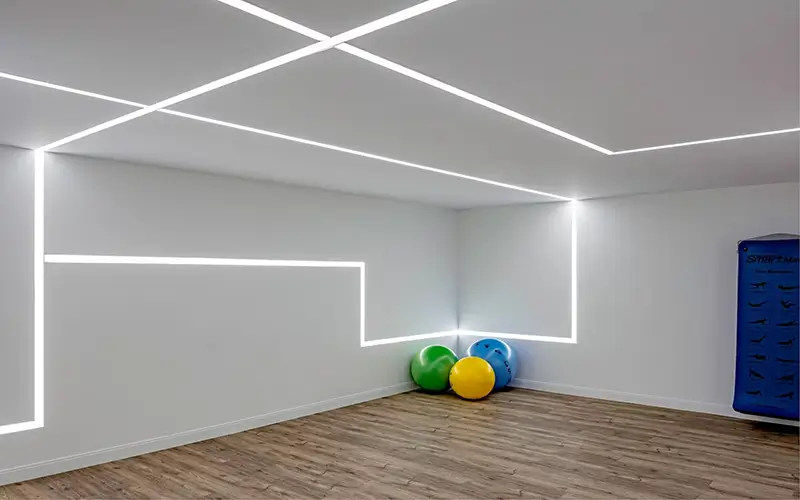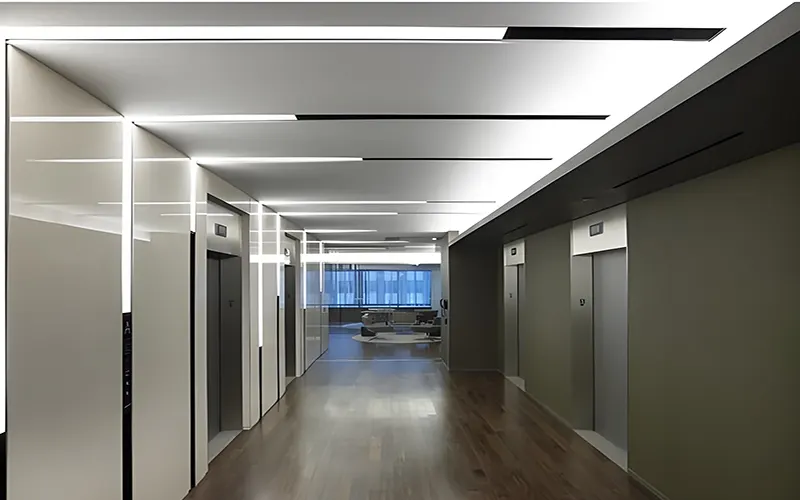
The field of architectural lighting has always been people’s pursuit of innovation. Most people usually use LED aluminum profiles in architectural lighting. These LED aluminum profiles have a high-quality material, aluminum, and a durable design that is corrosion-resistant and weather-resistant. Additionally, they come in different sizes, shapes, and colors, and one innovation that is changing architectural lighting is the use of LED aluminum profiles. They are easy to install and are a good choice for a variety of architectural lighting projects.
In this article, we will detail what LED aluminum profiles are, explore their role, and demonstrate how they perfectly apply to architectural lighting.
What is an LED Aluminum Profile?
LED aluminum profiles, also known as LED extrusions or LED strip channels. It is a housing specifically designed to house and protect an LED strip light. Its main raw material consists of aluminum casing.
Typically equipped with an opal cover or diffuser cover that houses the LED strip and helps distribute the light evenly. There are also end caps, end caps with holes, and end caps without holes. There are also matching mounting buckles that can well fix the positions of the LED aluminum profile.
What is the Main Function of LED Aluminum Profiles?
LED aluminum profiles play a key role in the lighting system and find wide application in architectural lighting and residential lighting. Its main functions are as follows:

Protect LED strip lights
Installing LED strip lights inside LED aluminum profiles protects LED light strips from physical damage, dust, and moisture. This ensures that the LED tape maintains normal performance.
Help dissipate heat
LED aluminum profiles is an excellent conductors of heat. So LED aluminum profiles help dissipate the heat generated by LED tape, preventing overheating and ensuring optimal performance. Thereby extending the life of the LED strip lights.
Uniform light
Most LED aluminum profiles has with LED diffusion covers. The colors of the diffusion covers are different, and their performance and light transmittance are different. It helps diffuse the light from the LED strips, resulting in softer, more even lighting.
Aesthetics of Lines
LED aluminum profiles have a sleek, modern look that enhances the aesthetics of your lighting fixtures. LED aluminum profiles offer options for surface mounting, recessing, or suspending, allowing LED strips to infuse spaces with vitality and external beauty.
Flexibility
LED aluminum profiles are available in a variety of shapes, sizes and colors, providing design and installation flexibility. It can support custom length and color. And is well-adapted to specific lighting applications and architectural designs.
Overall, LED aluminum profiles play a vital role in LED lighting solutions, providing protection, heat dissipation, diffusion, beauty, and flexibility for LED strip installation. LED aluminum profiles find widespread use in architectural lighting, interior design, signage, display lighting, and other applications requiring versatile and effective lighting solutions.
Can LED Aluminum Profiles be Used for Architectural Lighting?
LED aluminum profiles seamlessly integrate into architectural lighting and find extensive use in indoor architectural lighting, including ceilings, walls, stair and floors. They can use in different installation methods to decorate and illuminate architecture.
What are the Advantages of Using LED Aluminum Profiles in Architectural Lighting?
A variety of LED lights exist on the market for architectural lighting. But LED extrusions have always been favored by designers and engineers. One innovation that most people agree has transformed architectural lighting is the use of LED channel. Let’s take a closer look at the advantages of LED profiles used in architectural lighting.
Versatility of LED aluminum profiles
LED aluminum profiles are available in a variety of shapes, sizes and mounting installation options. Allowing designers to unleash their creativity. LED aluminum profiles offer customization ranging from sleek and minimalist profiles to bold and eye-catching designs, allowing them to complement any architectural style or interior design concept.

Seamless lighting design
LED aluminum profiles seamlessly integrate into architectural elements such as walls, ceilings, floors, and furniture. Slim and discreet, these fixtures blend into their surroundings, creating a cohesive and harmonious lighting scheme that enhances the overall aesthetic of the space.
Uniform lighting
LED aluminum profiles deliver uniform surface illumination, eliminating glare and hot spots commonly associated with LED strip lighting fixtures. This even light distribution creates a soft and inviting atmosphere, making it ideal for architectural applications where visual comfort is critical.
Support customization
LED aluminum profiles offer user-friendly customization, allowing designers to tailor lighting output to meet specific project requirements. LED aluminum profiles can all be fine-tuned to create the desired lighting effect and atmosphere.
In summary, LED aluminum profiles have revolutionized architectural lighting by offering unparalleled versatility, seamless lighting design, uniform illumination, and customization options. As the demand for innovative lighting solutions continues to grow, LED aluminum profiles will undoubtedly remain at the forefront of architectural lighting design, shaping the way we experience and interact with the built environment.
What kind of LED Aluminum Profiles can be Used for Architectural Lighting?
Different LED aluminum profiles have different installation methods. And there are many types of LED aluminum profiles available for architectural lighting. To meet different architectural lighting requirements and design preferences. Here are some common LED aluminum profile types that can be used for architectural lighting:
Suspended LED aluminum profile
Suspended LED aluminum profile adopts a straight and slender design. Architects mainly suspend it from the ceiling and use it as the primary architectural lighting. It typically installs in wide spaces to provide high brightness and uniform lighting, achieving various lighting effects.
Corner LED extrusions
Corner LED aluminum profiles are designed for installation in corners, providing seamless lighting integration around corners and edges. They come equipped with additional mounting buckles, which users need to purchase separately. They help create visually appealing lighting designs while ensuring uniform lighting throughout the building space.
Surface Mount LED channel
Surface mount LED aluminum profiles attach directly to the surface of a wall, ceiling or furniture with decorative lighting and are easy to install. They come in a variety of shapes, sizes and finishes to complement different architectural styles and design concepts.
Recessed LED aluminum profiles
Recessed LED aluminum profiles install flush with the wall, ceiling, or floor surface, forming a seamless integration. Provide stylish and simple lighting solutions. They help reduce glare and create a clean, uncluttered look in architectural spaces while providing even lighting.
Overall, the choice of LED aluminum profiles for architectural lighting depends on factors such as lighting requirements, design preferences, installation conditions, and environmental conditions. You need to choose the correct installation method of LED extrusions for architectural lighting while achieving an efficient and effective lighting solution.
Where can LED Aluminum Profiles be Installed in Architectural Lighting?
LED aluminum profiles can perfectly integrate into various locations within the architectural space, enhancing the lighting beauty and design style atmosphere. The following is a detailed analysis of the specific installation locations of LED channel in architectural lighting:

Ceiling architectural lighting
- Suspended LED aluminum profiles can be hung from the ceiling to create indirect lighting effects.
- The LED aluminum profiles can be embedded in ceiling gaps to provide ambient lighting.
- LED aluminum profiles are installed along the perimeter surface of the ceiling for accent lighting.
Wall architectural lighting
- Surface mounted or recessed along walls to provide vertical lighting.
- Recessed LED aluminum profiles are embedded into wall panels or architectural features for decorative lighting.
Ground architectural lighting
- Embed LED aluminum profiles into floor channels or grooves for path lighting or wayfinding.
- Install along baseboard or baseboard surfaces for low-level ambient lighting.
- Furthermore, LED aluminum profiles can be installed into stairs or steps for safety and decorative purposes.
Cabinet architectural lighting
- Install LED aluminum profiles into display cabinets for accent lighting.
- Install countertops or cabinets for task lighting in the kitchen or bathroom.
- Mounted on furniture such as bed frames or headboards for decorative lighting.
Architectural lighting features
- LED aluminum profiles can be integrated into architectural elements such as columns and arches for emphasis.
- Install LED aluminum profiles along the edges of architectural details such as beams or moldings to highlight them.
- Embed into structural elements such as handrails or railings to provide security and decorative lighting.
In summary, LED aluminum profiles allow installation at different locations within the architectural building space, creating diverse lighting effects, enhancing visual appeal, and improving functionality. By strategically placing LED profiles, designers can transform the built environment, create dynamic lighting scenes, and enhance the overall spatial experience for occupants and visitors.
Summarize
LED aluminum profiles can be perfectly installed into architectural lighting spaces. How to choose LED strip channel for architectural lighting mainly depends on factors such as lighting requirements, design preferences, installation methods, and environmental conditions.
By choosing the right LED aluminum profile, designers can enhance the visual appeal, functionality and ambience of architectural spaces while achieving efficient and effective lighting solutions. We are an LED profile manufacturer; please contact me if you have any needs.
FAQs
Architects increasingly use LED aluminum profiles in architectural lighting, including suspended, recessed, and surface-mounted lighting. Primarily designed to house LED strips, providing protection, diffusion and versatility to lighting designs.
Designers will employ various forms of LED aluminum profiles for architectural lighting. Common types of LED aluminum profiles include suspended profiles, corner LED profiles, embedded profiles and surface-mounted profiles. Each profile meets different lighting needs and design preferences. .
Yes, both LED aluminum profiles and LED light strips support customization. Users can customize LED aluminum profiles in shape, size, appearance, and light output to meet the specific requirements of a building project.
Installers typically place LED aluminum profiles inside buildings, primarily in ceilings, walls, floors, furniture, architectural features, outdoor spaces, commercial areas, hotel environments, etc.
First, consider the lighting purpose and then select the appropriate LED light strips and LED aluminum profiles. Also consider design preferences, installation location, environmental conditions, budget, and compatibility with LED light strips and lighting controls.




